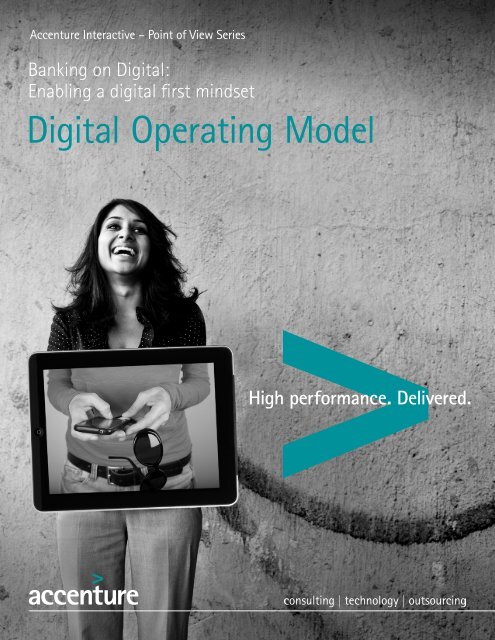1zqnVJw
1zqnVJw
1zqnVJw
Create successful ePaper yourself
Turn your PDF publications into a flip-book with our unique Google optimized e-Paper software.
Accenture Interactive – Point of View SeriesBanking on Digital:Enabling a digital first mindsetDigital Operating Model
DigitalOperatingModelSociallyEngagingBankingDigitalRelationshipManagementDigitalIntelligenceIntegratedExperienceDesignDigitalFirstEverywhereBankingPost-loginCustomerExperienceDigital Operating ModelThe Digital Operating Model is one of seven enablersdesigned to help financial services providers renew the customerexperience in the digital era. Adopting a “Digital First” mindset—putting digital at the heart of the business—enables banksto redefine their relationship with their customers.Find out more: www.accenture.com/bankingondigitalEstablished financial services providershave a complex web of product and servicetouchpoints, third-party vendors, andmarketing processes across channels andofferings. In many cases, multiple teamstake responsibility for digital operationsacross one or many business units. Thechallenges involved in coordinating digitaloperations often lead to inconsistentmessaging, process and infrastructureinefficiencies, security concerns, higheroperating costs—and a disjointed digitalexperience for customers.As companies scale-up digital operationsto offer a differentiating experience, lackof coordination, dedicated resources andprioritization can create a roadblock forexecution and innovation. The abilityto provide a compelling customerexperience and a high performing digitalorganization hinges on selecting the rightdigital operating model for your businessand developing the right capabilities toefficiently execute against the strategy.Why Does the DigitalOperating Model Matter?With an effective digital operating modeland robust execution capabilities in place,financial services companies can achievethe following:Greater agility, speed and innovationat scale: With powerful executioncapabilities, digital strategies can bedelivered at scale and speed, withstreamlined processes and well-definedgovernance. Reusing assets and bestpractices help spread innovation.Teams can design, test and launch newservices and products quickly beforescaling across the organization.Improve sales and customer intimacy:Coordinated execution capabilitiesallow companies to get a single view ofcustomer activities and preferences acrossproducts and channels. This can enrichcustomer interactions and boost salesopportunities through cross-selling,up-selling and timely offers.Reduce costs: A well-defined operatingmodel helps drive economies of scale.With structured and robust execution,companies can expand or contractresources to meet business needs,maximizing best use of digital talentand resources.
Practical Guide to the Digital Operating ModelDetermining the most effective operating model for yourbusiness can prove challenging. But it’s important to think aboutthe capabilities required to execute, as much as the strategy.Before companies decide whichmodel to adopt, they willneed to answer the followingfundamental questions:• Does it make sense tocentralize, and to whatextent?• What is the level of maturityin digital operations, and whatrole does digital play in futurebusiness plans?The degree of centralization that a companyadopts for its digital operating modeldepends on its priorities, level of desiredcontrol, business model (global vs. regional),and common synergies from the customer’sperspective. Financial institutions will alsoneed to consider how their approach couldhelp develop digital skills, launch newcustomer propositions, and rapidly and costeffectivelyadvance technology change.Companies can select one of the fourdigital models (Figure 1) most appropriateto their needs. Each model will have adedicated digital execution arm withinor across business units to coordinateoperations and deliver against the strategy.Committing to a digital model is notirrevocable and, as a financial institutiongrows or changes, it is possible to adopta different, more suitable model.Figure 1: Four Digital Operating ModelsDecentralizedDigital is low priority/early stage of developmentShared ServicesDigital is minorpriorityCenter ofExcellence (CoE)Digital is major priorityCentralizedDigital is coreto the businessCorporate Corporate CorporateDigitalCoEIntegratedDigitalPlatformCorporateBusinessunitBusinessunitBusinessunitBusinessunitBusinessunitBusinessunitBusinessunitBusinessunitDigitalstrategyDigitalstrategyDigitalstrategyDigitalstrategyDigitalstrategyDigitalstrategyStrategy & executionDigitalexecutionDigitalexecutionDigital execution(shared services)Digital execution(as shared services)Technical infrastructureTechnical infrastructureTechnical infrastructureTechnical infrastructure
Option 1. Decentralized ModelFinancial services companies may choosethis option if they prefer their digitalstrategy and execution to be tied toindividual business units, and wherecomplexity between departments isrelatively minimal. Each business unitmanages its own digital strategy anddelivers digital activities separately,with little exchange between them.Pros:• Digital strategy, resources and assetsremain very close to the individualbusiness unit’s or function’s needsCons:• Companies have little opportunityto reuse or scale-up digital assetsor content• Development cycles are long withlittle flexibility• IT costs can explode with growthOption 2. Shared Services ModelIn this model, each business unitmanages its own digital operations andpriorities. Business units have their owndigital marketing services and digitaltechnology investments, while thecentralized shared services, that areIT-driven, focus on the execution.Pros:• Digital strategy remains close tothe business unit’s needs• Helps develop a scaled pool of skilledresources to quickly and flexiblyramp-up digital technology needsacross different business units• Provides a degree of cost efficiencyCons:• Accountability between business andIT is split, and success is dependent onthe effective collaboration betweenthe two organizationsOption 3. Center of Excellence(CoE) ModelA CoE provides central access to digital skillsand delivery, combined with close links toother business units. Business units set theirdigital strategy and will manage specificdigital technologies, while the CoEstandardizes and shares applications,processes, data and business functions todrive greater consistency. The CoE offers arange of digital business services (e.g. socialmedia, analytics) and marketing campaignsacross business units.Pros:• Central access to digital skills and deliveryhelp improve IT and business alignment• Improved consistency by adoptingbest practices across business unitsCons:• Dual reporting may limit businessunit control• Requires heavy governanceOption 4. Centralized ModelIn this model, digital products and servicesare well integrated across channels.The IT platform and business services arecentralized, and a dedicated team takesresponsibility for digital strategy andexecution. The organization has moved toa standard digital platform, which allowsrapid and cost-effective implementation ofnew digital campaigns and tactics. Businessservices encompass a range of moresophisticated capabilities, such as digitalmarketing outsourcing, loyalty managementservices and analytics-as-a-service.Marketing communications are designed fordigital channels first, then deployed to others.Pros:• Drives business agility, growth,cost reductions and innovation• Provides a dedicated focus of resourcesand mandate to execute digital acrossthe organizationCons:• Smaller business units’ priorities maynot get the dedicated focus andattention of larger business unitsBuilding Robust DigitalExecution CapabilitiesSelecting a digital operating model isnot enough to create a high performingdigital organization. Regardless of thedigital model adopted, financial servicesinstitutions will need to develop a robustdigital execution arm within or acrossbusiness units. The digital executioncapabilities should encompass allof the following areas:Innovation, Strategy and Governance• Provide central focus andleadership on digital strategy• Own digital governance and allcustomer insights• Foster digital innovation bycollecting and socializing digitalideas that can originate anywhereExecution and Expertise• Accountable for tactical expertiseand project execution within thedigital channels• Responsible for each channel’sdeployment and the resultingcustomer experienceDigital Foundation• Plan, build and maintain thefoundational elements of all data,content and technologyDigital Management• Manage the processes, priorities andapproaches of digital deployment andmaintenance. Coordinate logisticalaspects of user experience projects,including planning, budgeting andprogram managementChange Management• Execute organizational changemanagement and associatedcommunications related to thedigital organization and strategyDigital Knowledge Management• Organize, archive and disseminatecustomer experience documentationand digital standards fromexpert groupsA digital execution engine encompassingall of these areas is one of the criticalcomponents necessary to drive thedigital organization forward.
ConclusionUnderstanding the role of digital in their organisationand moving to the right model can help financial servicescompanies transform operations and place digital at theheart of their business.Doing so can help them make the most of new enablingtechnologies to better engage with customers. Companieswho successfully create a culture of digital innovation andexperimentation are also better prepared to respond moreflexibly to the changing financial services market.Contacts:Joydeep Bhattacharyaj.a.bhattacharya@accenture.comNishant Thusoonishant.thusoo@accenture.com
About Accenture InteractiveAccenture Interactive helps the world’s leading brands drive superior marketingperformance across the full multichannel customer experience. Working with over 5,000Accenture professionals dedicated to serving the marketing function, Accenture Interactiveoffers integrated, industrialized and industry-driven digital transformation and marketingsolutions. Follow @AccentureSocial or visit accenture.com/interactive.About AccentureAccenture is a global management consulting, technology services and outsourcingcompany, with 266,000 people serving clients in more than 120 countries. Combiningunparalleled experience, comprehensive capabilities across all industries and businessfunctions, and extensive research on the world’s most successful companies, Accenturecollaborates with clients to help them become high-performance businesses andgovernments. The company generated net revenues of US$27.9 billion for the fiscalyear ended Aug. 31, 2012. Its home page is www.accenture.com.Copyright © 2013 AccentureAll rights reserved.Accenture, its logo, andHigh Performance Deliveredare trademarks of Accenture.This document makes descriptive reference to trademarks that may be owned by others. The use of such trademarks herein is not an assertion of ownership of suchtrademarks by Accenture and is not intended to represent or imply the existence of an association between Accenture and the lawful owners of such trademarks.Information regarding third-party products, services and organizations was obtained from publicly available sources, and Accenture cannot confirm the accuracyor reliability of such sources or information. Its inclusion does not imply an endorsement by or of any third party.The views and opinions in this article should not be viewed as professional advice with respect to your business.



